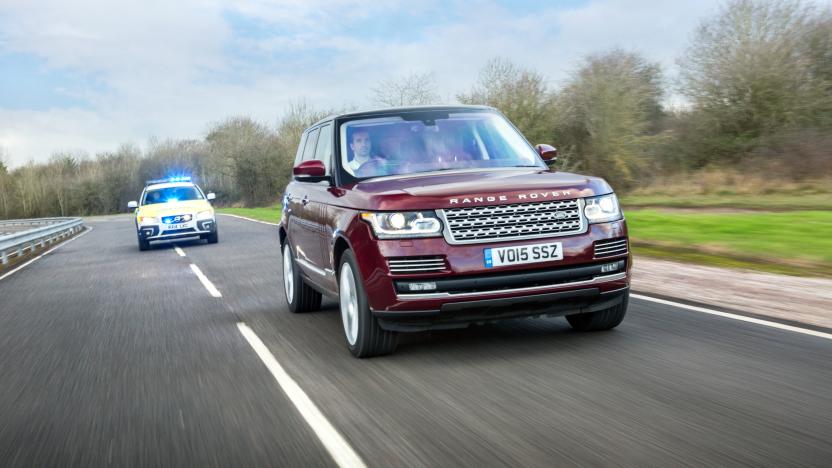motorway
Latest

UK to test self-driving trucks later this year
Later this year, the UK will open up its motorways to self-driving trucks under new plans to speed up deliveries and cut traffic congestion. The Times reports that Chancellor George Osborne will confirm funding for the project, which could see convoys of up to 10 autonomous trucks -- or lorries as Brits call them -- driving a few meters apart, during this month's budget announcement, helping Britain position itself as one of the leading proponents of self-driving vehicles.

UK to test self-driving cars on 41 mile 'connected corridor'
The UK government has dipped into the public purse once again to help finance a handful of autonomous car projects. One of the more interesting proposals is a 41 mile "connected corridor" that will test a number of self-driving car technologies. Specifically, engineers want to look at different connection types -- LTE, local WiFi hotspots, LTE-V and DSRC -- that could be built into cars and roadside infrastructure such as traffic lights and overhead gantries. The idea is to continuously feed information between traffic agencies, drivers and autonomous vehicles, so that they can all take the safest and smartest course of action on the road. So if a lane is closed or a truck breaks suddenly, everyone is alerted and knows how to react. The project has a range of contributors, including Jaguar Land Rover, Huawei and Vodafone. The consortium also includes Coventry City Council, Coventry University and the University of Warwick, which makes sense given this is where the "living laboratory" will be based. Jaguar Land Rover says the experiments, if successful, should make travelling safer and smoother for passengers. When a car wants to change lanes or exit the motorway, for instance, it'll be safer if every vehicle knows their intended route in advance. Similarly, "platooning" can maintain equal spacing between cars, ensuring safety and maximum fuel efficiency. When an accident occurs up ahead, that information could also be communicated to every vehicleIt'll test information-sharing between autonomous cars and regular drivers. on the road, including those controlled by human drivers using a mixture of visual and audio-based alerts. Dr Wolfgang Epple, director of research and technology at Jaguar Land Rover said: "The approach of an emergency vehicle can often be stressful for drivers. If we can inform the driver, or the autonomous car, much earlier that an emergency vehicle is approaching, we can ensure that the best decisions are made to move the vehicle out of the way safely and conveniently, to let the emergency vehicle pass by." Like most of the UK's autonomous car projects, this will be an early look at how the technology can be rolled out safely. If and when the government decides to properly legislate self-driving vehicles, it'll be case studies like this one that inform its decisions and the sort of systems that manufacturers need to adopt. An important foundation, not just for road safety but reassuring the public that it's ready for prime time.

British highway to become internet-connected 'network of sensors' over 50-mile stretch
In a team-up between the UK's Department of Transport, BT and Cambridge start-up Neul, the A14 (which connects Felixstowe to Birmingham) will be transformed into the country's first internet-connected road, with the aim of preparing the country for future tech from wireless toll chargers to automated cars. The smart road will include a network of sensors across a 50-mile segment, with data transmission delivered over white space. Ofcom approved the project yesterday, alongside its plans for the rest of the spectrum space. According to the regulator, "sensors in cars and on the roads monitor the build-up of congestions and wirelessly send this information to a central traffic control system, which automatically imposes variable speed limits that smooth the flow of traffic," Ofcom said. "This system could also communicate directly with cars, directing them along diverted routes to avoid the congestion and even managing their speed." Initial plans for the A14 aren't focused on these borderline zealous goals just yet. Instead, the project aims to gather information on the cars that use the A14, before focusing on heavy goods vehicles, feeding back to a database that the government's Department for Transport will be able to access. As The Guardian notes, the project would offer a cheaper method for data connectivity and gathering traffic information compared to the mobile network techniques used by companies like TomTom. Instead of connecting to pricey mobile masts, the project will tap into small base stations attached to street lamps or BT exchanges, many of which already exist along the hectic A-road. (Image credit: Martin Pettitt, Flickr)

Smart speeding sign flashes your license plate number
The M42 is a major British motorway that has a reputation for being a testbed for new roadside technology, with a current traffic management scheme including sensors for tracking traffic built into the road and variable speed limit signs every 500 meters. The latest piece of kit to be tested out during roadworks is a radar-assisted speeding sign that not only flashes when it detects a speeding car, but also displays the license plate number of said car. Yeah, scary. Apparently the public shame (or swift realization that it could also be an automated ticket-writer) that the sign dishes out to speeding motorists is having some effect, with 50% of drivers slowing down once they see their number is up. Presumably the other half were concentrating too hard on getting out their digicams -- look ma! I'm on a roadsign! -- to slow down.[Via Autoblog]


